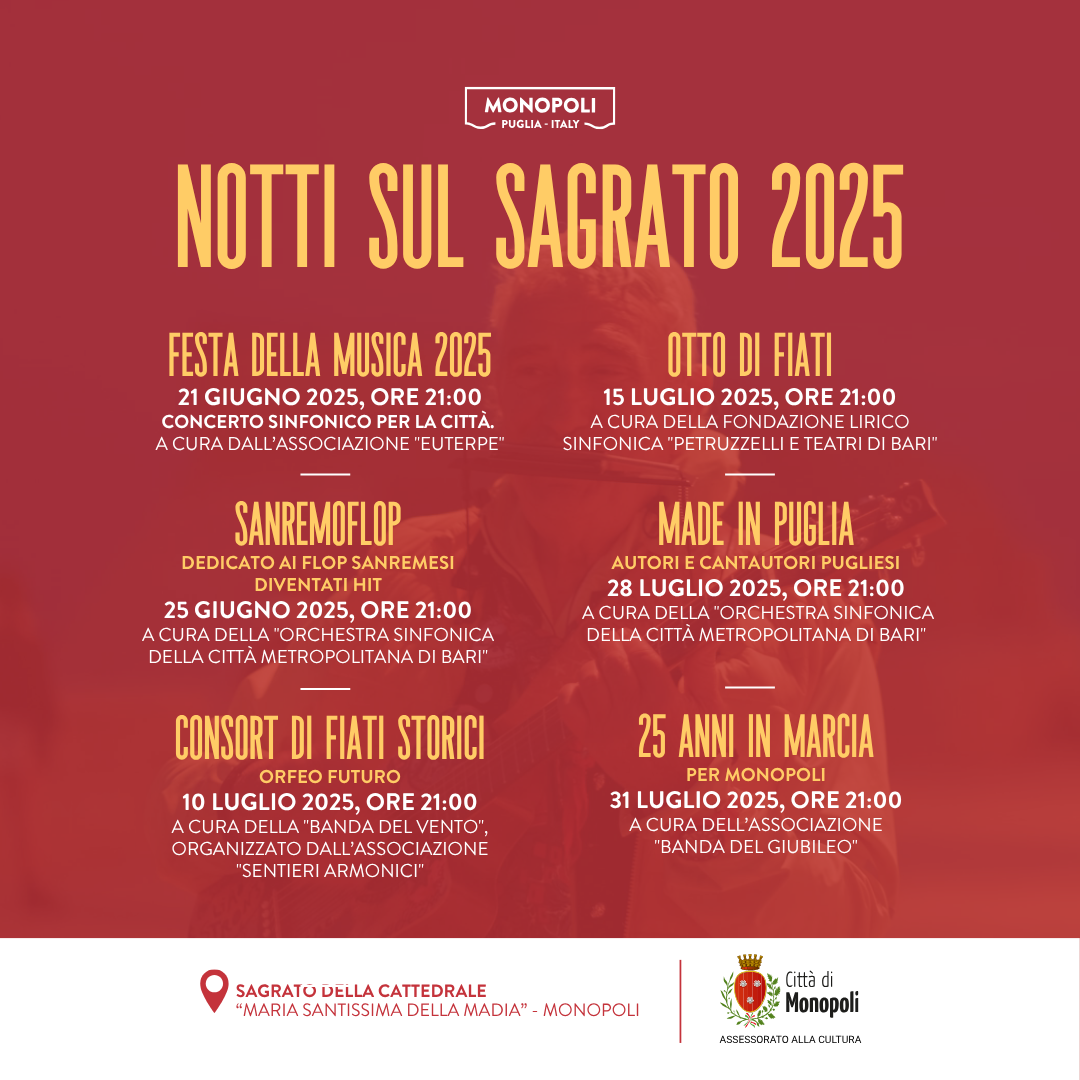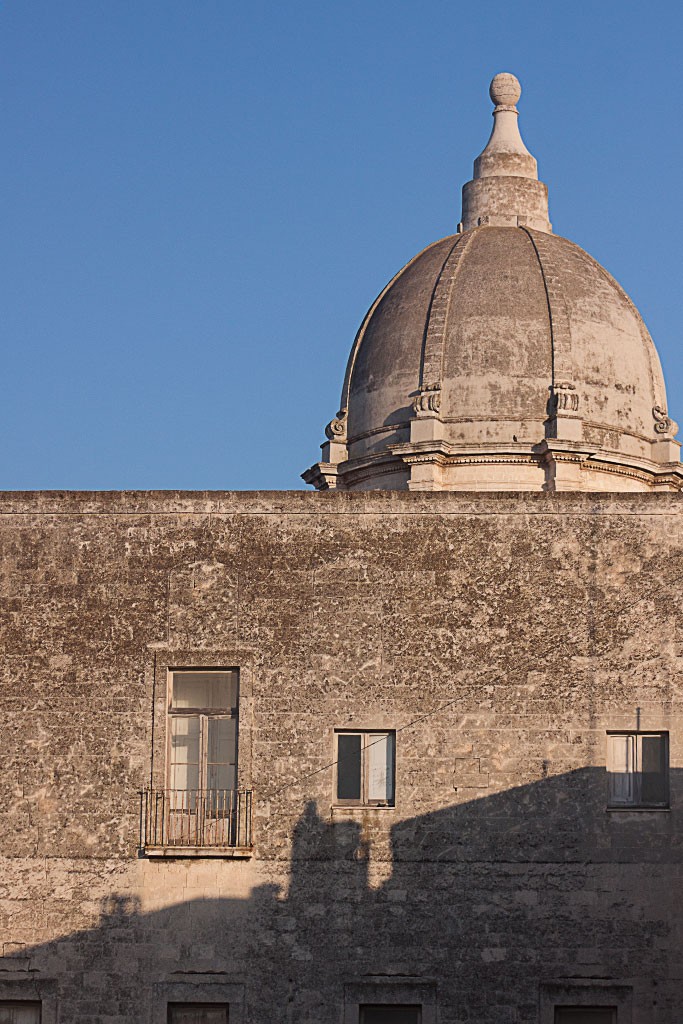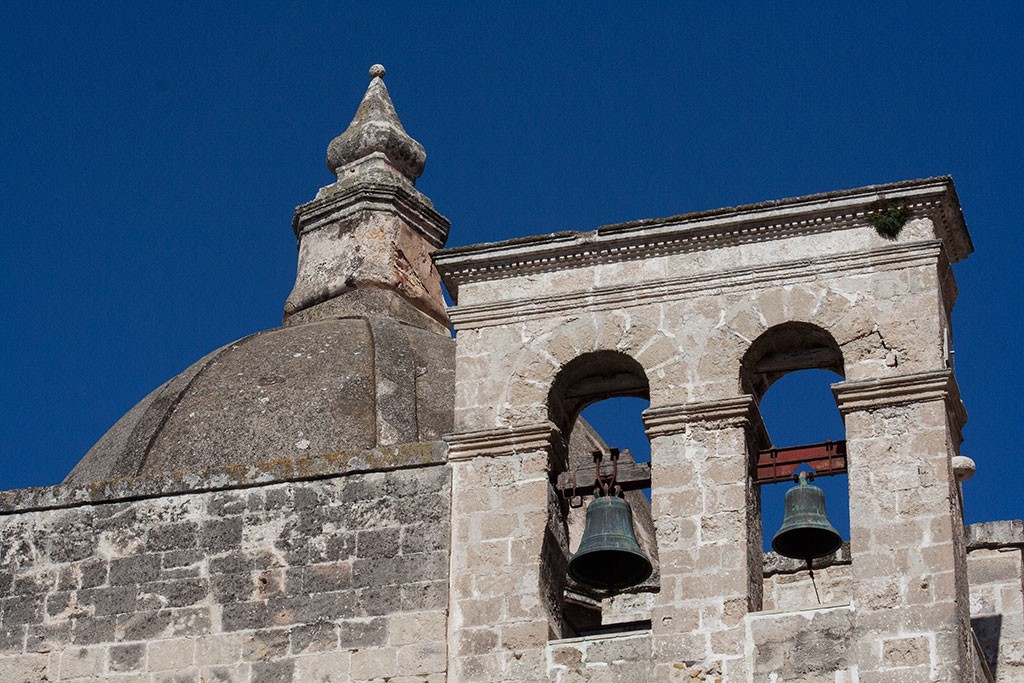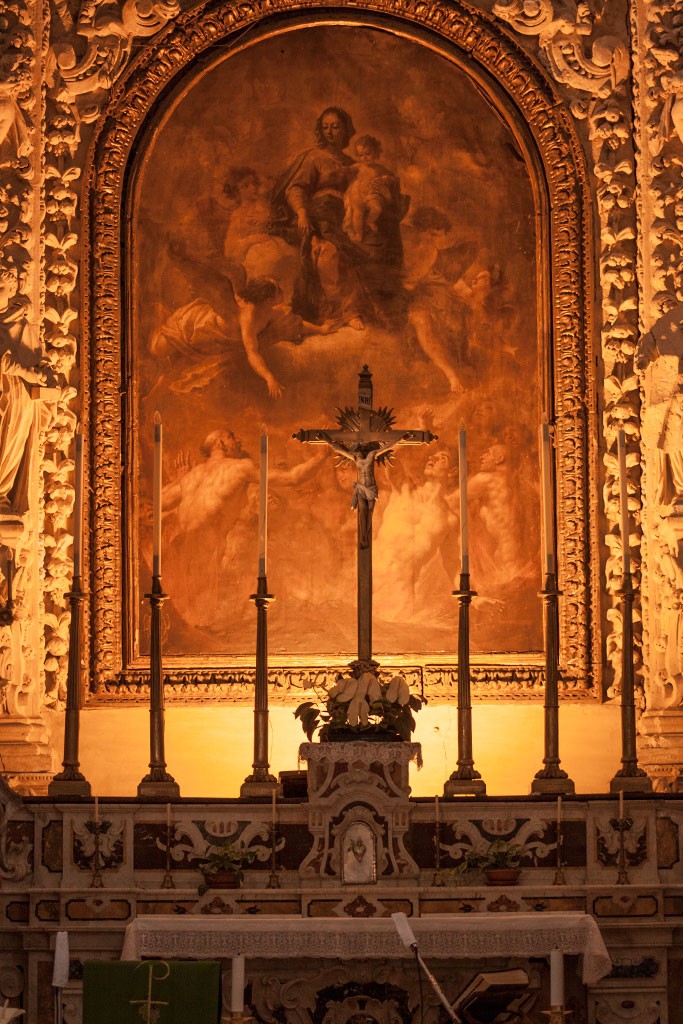Chiesa del “Purgatorio” | Palazzo Palmieri | Chiesa dei Santi Pietro e Paolo | Chiesa di San Giovanni | Chiesa di S. Vito | Chiesa di San Salvatore | Santa Maria della Zafarra
It will be a truly fascinating journey that will lead you to discover the signs of sacred art in a town in where the church has had a very important role in its history and one of power. It is not by chance then that in the old town there is a high concentration of churches, almost one on top of one another in fact they number more than twenty open and closed places of worship.
The Church of St Leonard
Starting from another “treasure chest” of significant importance to discover local religious history and its signs in art, that is the Church of San Leonard, you could not start any another route in the heart of the old town that takes you to appreciate places of worship steeped in culture.
-
Surrounding area (maps)
-
Learn more about the Church of St Leonard
A visit to the Church of Saint Leonard remains one of those fundamental stops to take full advantage of the most noteworthy local sacred art. The building, completed in 1745, was finished by the well-known Salentino architect Mauro Manieri, who was also a sculptor and painter. He is well known for his realisation of the façade of the Cathedral of Taranto and the Church of Alcantarine in Lecce. This refined church is fascinating for its façade in two orders, Ionic and Corinthian, and one where you can appreciate the work carried out by Manieri. A beautiful façade embellished with a fine mixtilinear Portal with festoons and a niche in which is the bust of Saint Leonard all in late Baroque style where the hand of Manieri is clearly evident. Highly interesting is his way of combing the classical forms with inventive patterns and friezes. The curved semi-arches of a gable leave the window and its pediment the space and light they deserve. Inside there is a single nave with a number of side chapels and a large dome. However, the masterpiece is the cross-vaulted ceiling combined with the refined light of the stuccoes. In the heart of the presbytery you will notice the presence of a number of paintings from the 16th and 17th Century that are by artists from the Venetian and Neapolitan schools. The high altar is a particular example of Neapolitan workmanship and is attributed to the workshop of Aniello Gentile. Particularly worthy and dating back to the second half of the 18th century is the door of the tabernacle; in silver it depicts a pelican the Christian symbol of charity. In reality everything here is of noteworthy value: from the majolica floor tiles under the high altar to the ‘corretti’ on the arches of the side chapels, with lattices, behind which the cloistered nuns attended the religious functions. Along the gallery there are about two hundred sacred objects that make up part of a museum collection. Let us also recall that the church is built on the old crypt of St. Michael the Archangel, where, according to tradition, preached St. Peter.
The Church of Saint Teresa
From the Church of Saint Leonard and turning towards the Church of St Teresa you will find yourself in the middle of piazza Palmieri. Here you will be close to one of the many churches enclosed and protected by the walls of the “Old Town”: that of St. Peter and Paul, St. John, St. Mary of Zaffara, St Salvatore and San Vitus, large and small treasure chests that preserve traces of piety and art.
-
Surrounding area (maps)
-
Learn more about the Church of Saint Teresa
In the area around piazza Palmieri, on the left of ‘via santa Teresa’, you can find the church of Santa Teresa (St Teresa). You will immediately recognize it by its high apsidal dome, visible from various points in the Old Town and certainly the largest in the town. The church dating back to the 18th century has an attached convent where once resided the Teresian nuns. Its beautiful façade is in baroque style whose play on concavity and convexity whisks you away. The internal structure takes the form of a Latin cross therefore there is a single nave with a series of interesting side chapels. An aspect that strongly characterizes the interior and one which first strikes you is the white of the walls. The only touches of color are derived from the canvases, from the altars and from the dark and austere confessional. We can also see two beautiful balconies the one on the left is used for the choir and the one on the right for the organ which is now in the Oratory of the Cathedral. The main altar was originally in ‘tufo’ (a local limestone rock) and then was replaced with one of marble, behind which and in the centre of the apse is a large painting of Maria Santissima tra i Santi (The Virgin Mary with the Saints), by Ignazio Montella. The wooden busts on the Central wall of the apse are two effigies of the relics of St. John of the cross and St. Theresa of Avila. Many of the paintings here come from the churches of Saints Peter and Paul and of St. Saviour. From the former comes ‘Martirio di S. Pietro’ the “Martyrdom of St. Peter”, a work which is reminiscent of St. Peter upside down on the cross by Guido Reni and a large painting of two Saints dating from 1635. From the latter comes ‘la Cena di Emmaus’ the supper at Emmaus from the 17th century, a large wooden crucifix from the 15th-16th century and two paintings by the Neapolitan artist Andrea Miglionico.
The Church of Purgatory
It can be found along the road that runs alongside the Cathedral and guides you towards the beach at “Porta vecchia”, it has stood for centuries in the shadow of the cathedral’s bell tower in via Nicodemo Argento. It is not difficult to stay and contemplate before the rich portal and heavy wooden door. Often you can find small gatherings of people who gaze through the nearby window intrigued by the sight that greets them, the mummified bodies of some of the church’s ancient brethren, for this reason, it is known by the locals as ‘the church of the dead that walk’
-
Surrounding area (maps)
-
Learn more about the Church of Purgatory
It is known as “Purgatory” because it was requested by the confraternity of St Mary of Suffrage (Santa Maria del Suffragio ) after the collapse of the bell tower of the nearby Cathedral in 1681. (In reality it was dedicated to the Nativity of the Virgin Mary). Built between the end of the 17th century and the beginning of the 18th century in baroque style the church from the outside displays an interesting façade of two orders. You will remain astonished by the façade which features a heavy wooden paneled door decorated with the effigies of two skeletons, a statue of St. Michael and exhibits decorated with skulls. The panels of the beautiful door, in the upper part, display the symbols of power and in the lower part, the instruments of work. The only thing which renders all levels of the social pyramid equal is death, a concept which is displayed by the two central skeletons in short, everything is summed up in the statement “The triumph of death”. The interior is in the form of a Latin cross with a dome and a high altar in ‘Pietra Leccese’ (a beautiful local limestone rock), made by Pasquale Simone and dating from around the mid 18th century. It is a wonderful example of baroque architecture with its interesting and rich decorations. The church houses a number of important works of art in particular “Souls in purgatory” by the artist Paolo De Matteis dating back to the early 18th century. You can also find the works of Domenico Carella. Equally beautiful is the work of Felice Scala in the chancel that houses an 18th century organ. For the more macabre there are a number of embalmed bodies of the church’s confreres on display in an annex room and which date back to the 18th and 19th century. This is the testimony that makes history for some of the church’s confreres that died between 1772 and 1832 and who decided to deliver their bodies to eternity through the process of natural embalmment (dehydration) at that time the fashion in the Kingdom of Naples. Some corpses wear the ‘mozzetta’ a cape worn by clergy and draped over the deceased in mourning decorated at the base with red flames to symbolize the flames of Purgatory. Others are the mortal remains of nobles, lawyers, even a governor of Monopoli, but above all brothers and sisters of the congregation of “Our Lady of Suffrage. Among the bodies is that of Plautilla Indelli a child of two years and the seed of the noble Indelli family.
Events in Monopoli

VAIMOO Bike Sharing has arrived in Monopoli
26 September 2025Bike sharing starts: 45 stations and 200 e-bikes. The service will be managed for a duration of nine years. Cost of…
Read More
“Venghino Signori Venghino” Street Circus Art Festival – September 20, 2025
11 September 2025Saturday 20 September 2025, starting from 8.30 pm, Monopoli will be transformed into a large open-air stage with “Venghino Signori Venghino”…
Read More
Ritratti Festival: 12 concerts from July 3 to August 10, 2025, in Monopoli
16 July 2025A musical experience capable of intertwining art and landscape, memory and experimentation, and promoting the talent of emerging young artists alongside…
Read More
Experience Summer 2025 in Monopoli | Events Schedule
15 July 2025Events, City Festivals, District Festivals… Enjoy your Summer 2025 in Monopoli, discover the Events Program! Download the program Potrebbe interessarti… Ritratti…
Read More
PhEST – International Festival of Photograpy and Art | MONOPOLI 08/08-16/11 2025
15 July 2025From August 8 to November 16, 2025, PhEST – International Festival of Photography and Art celebrates its tenth edition in Monopoli,…
Read More
From 21 June 2025 six “Nights on the Cathedral Square”
20 June 2025Opening night with the preview of the Ritratti Festival and the Rota Conservatory Orchestra This year too, Monopoli is preparing to…
Read More










